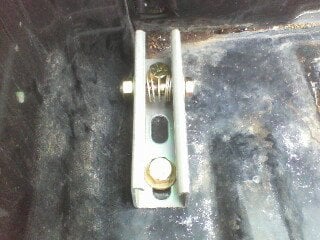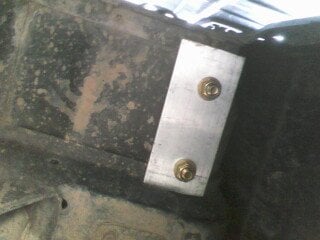In preparation for picking up a used Bobcat camper, my friend and I have installed a fastening system as follows. The main guidance is from what BillM did.
-- Superstrut: 12-gage ( = about 0.109 inches thick), 1.625" x 1.625", four 6-inch long pieces. Purchased 10-foot length from Home Depot for about $21.
-- Cross-bolts: 7/16-inch Grade 8, four altogether, with two 7/16-inch Grade 8 washers for each. All bolts purchased from Home Depot or Lowe's.
-- Hold-down bolts: 1/2-inch Grade 8, eight altogether, two 1/2-inch Grade 8 washers per bolt.
-- Aluminum backing plate for underneath the truck: four 1/4-inch thick, 7" x 3" plates. Purchased from eBay for about $14.
-- Red Loctite, about $7
Cost of the superstrut, nuts, bolts and washers and some drill bits is now up to about $75 total. I had all the power tools already.
We spoke with Marty at ATC about the anchoring points (= cross-bolt locations).
The size of the aluminum backing plate will depend on what is underneath one's truck. One should get underneath and evaluate the dimensions before cutting the aluminum plate.
We were constantly measuring, of course, to get all drilled holes just right.
We torqued the hold-down bolts to 80 ft-lbs, per guidance on the net, and Loctited all nuts. Note that the lug nuts on a sedan vehicle's wheels are about 1/2-inch and typically tightened to about 80 ft-lbs. Torquing the 7/16-inch cross-bolts resulted in collapse of the superstrut, so we just snugged them and let them be. This argues for going with the 5/16-inch cross-bolts BillM used.
We will be using a locknut (jam nut) on the turnbuckles.
BillM said the Grade 5, 5/16-inch hold-down bolts had bent. I assumed a free-end beam and computed that the force on the cross-bolt was about 2100 to 3400 pounds to cause this failure of the hold-down bolts. But I could be wrong with many of my assumptions. I also did some calculations using the "Design Guide for Metal Cladding Fasteners" at the following address:
www.aamanet.org/mp/tir-a9-xx_d4_9-13-13_clean.pdf . I am pretty satisfied. Mostly BillM's experience and frequent monitoring are on what my friend and I will rely.
We are considering using happijac turnbuckles. These have some shock absorption. It seems to me that vibrations may be the bane of these fastening systems, along with tightening too much or too little on the turnbuckles. I am also contemplating what many have written about a three-point hold-down determining a plane and so arguably, one only wants to tighten three corners.
We are considering some cushioning between the truck bed rails and the camper as well.
We will be inspecting where the camper eyebolts attach to the camper. Per many recommendations at this site, we may be installing aluminum reinforcing plates, if the previous owner has not already.
Some hiccups and concerns so far:
-- I wonder whether orienting the superstruts laterally (instead of longitudinally = parallel to the corrugations in the bed) would be better. Especially for the front ones that take more of the load going up a hill. Oriented longitudinally, all the force from one corner of the camper may fall on one of the 1/2-inch hold-down bolts, assuming the 1/2-inch hold down-bolts are not perfectly placed in the superstrut's slots.
-- To cut the superstrut and aluminum plate, I used a $15 Angle Grinder with several 1/16-inch thick, 4-inch diameter, aluminum oxide cut-off wheels from Harbor Freight, item #s 60625 and 61353. This worked well on the superstrut. I could cut off a 6-inch piece of superstrut in about two minutes and feel safe doing so. Cutting the 1/4-inch thick aluminum plate was more difficult and took more care. I need to research why this was so difficult. Aluminum-based cutting wheel on aluminum plate = bad idea? Some sites say a circular saw with an appropriate aluminum-cutting blade will work better.
-- Buy several cobalt drill bits, from 1/16-inch for pilot holes to 1/2-inch, for drilling the holes in the superstrut and aluminum plate. We had some titanium drill bits and some cobalt drill bits. They either were dulling quickly or my 32-year-old tiny Black-and-Decker drill was overheating and so not operating at power some of the time. We let everything cool down periodically and got better drilling power. A titanium step drill bit from Harbor Freight Item #44460 was something of a workhorse for the final, larger holes and seems a good value for this job, given the thicknesses involved.
-- Getting a straight hole through the superstrut for the cross-bolt was difficult. Start with a long enough 1/16-inch pilot hole through both sides. A drill press would be preferable.
Photos are of the driver's side front fastener, top side and bottom. The top of the photos is the front of the camper bed. Rotate the view of the bottom about 30 degrees or so counter-clockwise to get a view as though you were laying beneath the truck, lying parallel to the corrugations in the bed.
Thank you again BillM and to many others who posted on this subject on the net.
-- Superstrut: 12-gage ( = about 0.109 inches thick), 1.625" x 1.625", four 6-inch long pieces. Purchased 10-foot length from Home Depot for about $21.
-- Cross-bolts: 7/16-inch Grade 8, four altogether, with two 7/16-inch Grade 8 washers for each. All bolts purchased from Home Depot or Lowe's.
-- Hold-down bolts: 1/2-inch Grade 8, eight altogether, two 1/2-inch Grade 8 washers per bolt.
-- Aluminum backing plate for underneath the truck: four 1/4-inch thick, 7" x 3" plates. Purchased from eBay for about $14.
-- Red Loctite, about $7
Cost of the superstrut, nuts, bolts and washers and some drill bits is now up to about $75 total. I had all the power tools already.
We spoke with Marty at ATC about the anchoring points (= cross-bolt locations).
The size of the aluminum backing plate will depend on what is underneath one's truck. One should get underneath and evaluate the dimensions before cutting the aluminum plate.
We were constantly measuring, of course, to get all drilled holes just right.
We torqued the hold-down bolts to 80 ft-lbs, per guidance on the net, and Loctited all nuts. Note that the lug nuts on a sedan vehicle's wheels are about 1/2-inch and typically tightened to about 80 ft-lbs. Torquing the 7/16-inch cross-bolts resulted in collapse of the superstrut, so we just snugged them and let them be. This argues for going with the 5/16-inch cross-bolts BillM used.
We will be using a locknut (jam nut) on the turnbuckles.
BillM said the Grade 5, 5/16-inch hold-down bolts had bent. I assumed a free-end beam and computed that the force on the cross-bolt was about 2100 to 3400 pounds to cause this failure of the hold-down bolts. But I could be wrong with many of my assumptions. I also did some calculations using the "Design Guide for Metal Cladding Fasteners" at the following address:
www.aamanet.org/mp/tir-a9-xx_d4_9-13-13_clean.pdf . I am pretty satisfied. Mostly BillM's experience and frequent monitoring are on what my friend and I will rely.
We are considering using happijac turnbuckles. These have some shock absorption. It seems to me that vibrations may be the bane of these fastening systems, along with tightening too much or too little on the turnbuckles. I am also contemplating what many have written about a three-point hold-down determining a plane and so arguably, one only wants to tighten three corners.
We are considering some cushioning between the truck bed rails and the camper as well.
We will be inspecting where the camper eyebolts attach to the camper. Per many recommendations at this site, we may be installing aluminum reinforcing plates, if the previous owner has not already.
Some hiccups and concerns so far:
-- I wonder whether orienting the superstruts laterally (instead of longitudinally = parallel to the corrugations in the bed) would be better. Especially for the front ones that take more of the load going up a hill. Oriented longitudinally, all the force from one corner of the camper may fall on one of the 1/2-inch hold-down bolts, assuming the 1/2-inch hold down-bolts are not perfectly placed in the superstrut's slots.
-- To cut the superstrut and aluminum plate, I used a $15 Angle Grinder with several 1/16-inch thick, 4-inch diameter, aluminum oxide cut-off wheels from Harbor Freight, item #s 60625 and 61353. This worked well on the superstrut. I could cut off a 6-inch piece of superstrut in about two minutes and feel safe doing so. Cutting the 1/4-inch thick aluminum plate was more difficult and took more care. I need to research why this was so difficult. Aluminum-based cutting wheel on aluminum plate = bad idea? Some sites say a circular saw with an appropriate aluminum-cutting blade will work better.
-- Buy several cobalt drill bits, from 1/16-inch for pilot holes to 1/2-inch, for drilling the holes in the superstrut and aluminum plate. We had some titanium drill bits and some cobalt drill bits. They either were dulling quickly or my 32-year-old tiny Black-and-Decker drill was overheating and so not operating at power some of the time. We let everything cool down periodically and got better drilling power. A titanium step drill bit from Harbor Freight Item #44460 was something of a workhorse for the final, larger holes and seems a good value for this job, given the thicknesses involved.
-- Getting a straight hole through the superstrut for the cross-bolt was difficult. Start with a long enough 1/16-inch pilot hole through both sides. A drill press would be preferable.
Photos are of the driver's side front fastener, top side and bottom. The top of the photos is the front of the camper bed. Rotate the view of the bottom about 30 degrees or so counter-clockwise to get a view as though you were laying beneath the truck, lying parallel to the corrugations in the bed.
Thank you again BillM and to many others who posted on this subject on the net.





